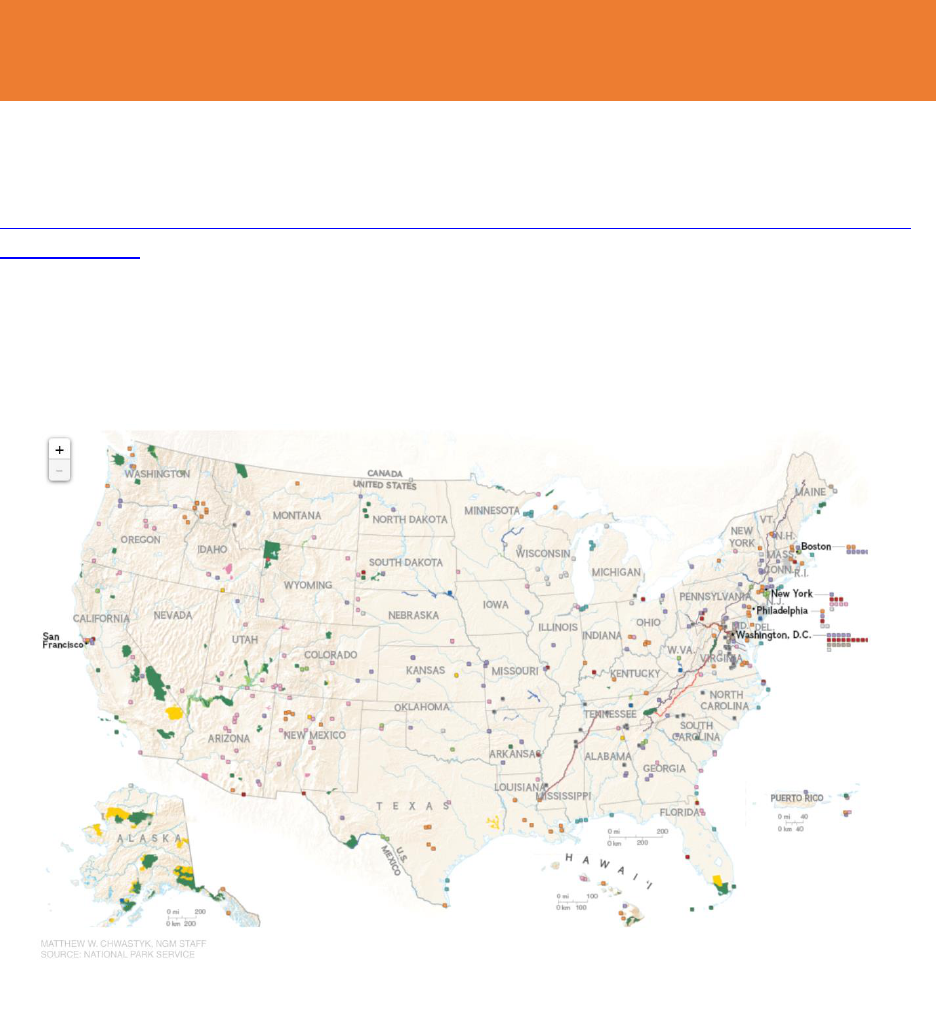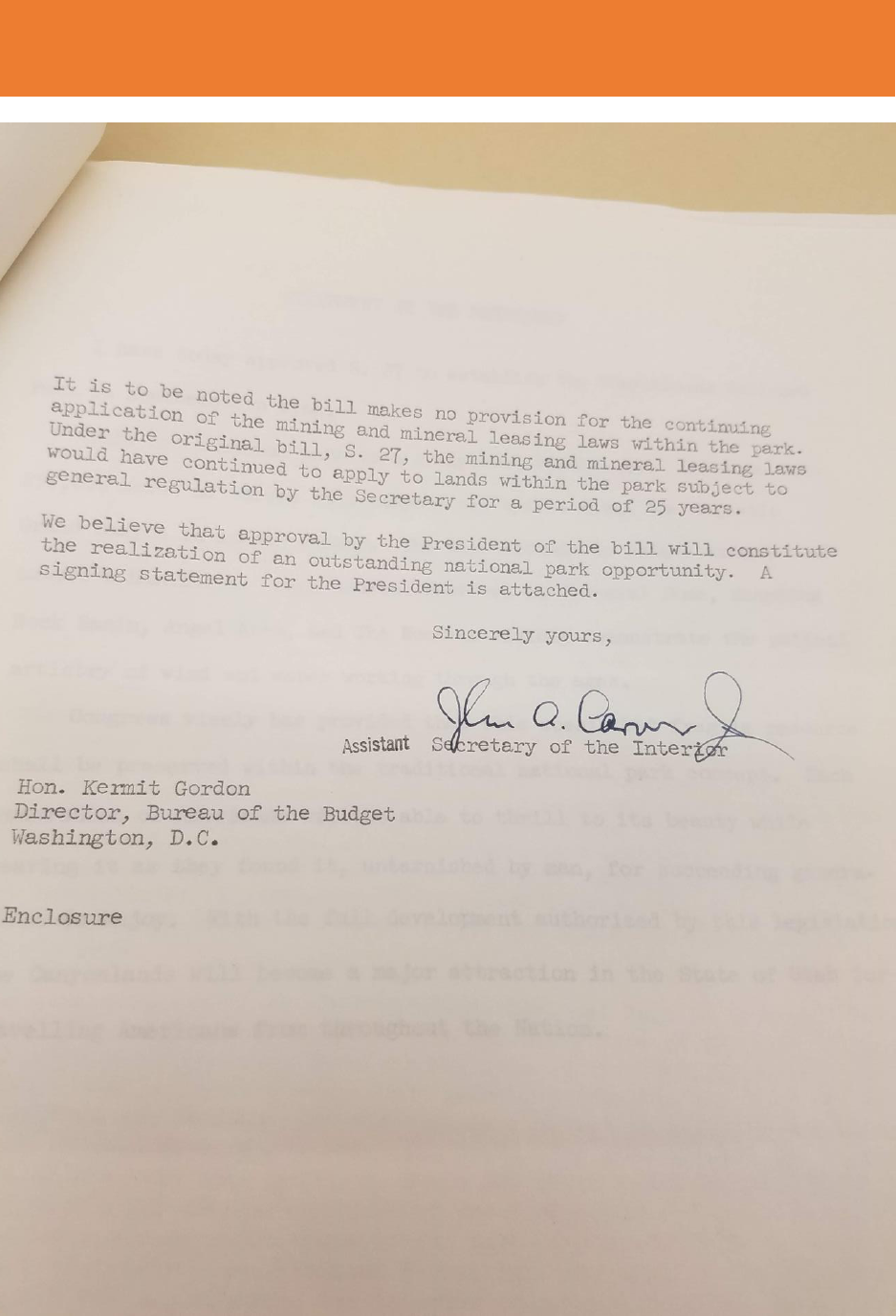
“Creative Conservation:” The Environmental Legacy of
Pres. Lyndon B. Johnson 1963-1969
2
Table of Contents
LBJ and the Texas Hill Country 5
Overview 5
Activity: Sense of Place and LBJ’s Texas 6
Great Depression and Activity 22
Rural Electrification and Activity 28
TEKS 28
Sources 35
The Great Society Responds to the Environmental Crisis 38
Overview 38
The Environment and the Great Society 39
LBJ’s Environmental Legislation 40
Activities & Additional Resources 41
TEKS 45
Sources 56
Lady Bird Redefines Beauty 57
Overview 57
The Environment and the “Great Society” 58
Lady Bird’s Beautification Projects 59
Lady Bird Johnson Wildflower Center 60
Activity 61
TEKS 70
Sources 75
LBJ Expands the National Park System 78
Overview 78
LBJ’s Contribution to the NPS 79
Activity 80
TEKS 87
Sources 93

“Creative Conservation:” The Environmental Legacy of
Pres. Lyndon B. Johnson 1963-1969
78
LBJ Expands the National Park Service
Overview Providing Context for Educators
The United States National Park Service is over 100 years old. It was formally created in 1916
under President Woodrow Wilson, although National Parks themselves go back even farther in
the country’s history. Abraham Lincoln approved the creation of Yosemite as a state park in
California in 1864. Congress passed legislation creating Yellowstone as the nation’s first National
Park in 1872 during the presidency of Ulysses S. Grant.
Teddy Roosevelt is often referred to as the “Conservation President.” He created the National
Forest Service, and put more land under federal protection, whether as National Park, National
Forest, Wildlife Refuge, or National Monument than any other President. He signed into law the
Antiquities Act, which safeguarded early Native American ruins and antiquities.
During his New Deal, President Franklin Roosevelt, mobilized his Civilian Conservation Corps to
work in national parks to build and repair roads, bridges, plant trees, and make improvements.
He oversaw transfer of federally owned and operated national cemeteries, monuments, and
historic sites to the administration of the National Park Service. Truman, Eisenhower and
Kennedy all added acres to our National Parks.
President Johnson’s “Great Society”
President Johnson introduced ideas relevant to the “Great Society” at the University of Michigan
commencement on May 22, 1964, calling on the government and citizens to renew man’s
contact with nature, reminding those in the audience that, “we have prided ourselves on being
not only America the strong and America the free, but America the beautiful.” The idea of
“quality of life” was a key theme in Johnson’s vision for a “Great Society.”
Although racial equality and the elimination of poverty were the primary goals of the program,
Johnson felt that environmentalism, especially where it concerned pollution and degradation of
the natural and urban environments should be included in the goals of a better America
envisioned by the “Great Society.” President Johnson felt that all Americans should be able to
spend time in nature and appreciate our nation’s beauty. Therefore, he wanted to create more
parks and wildlife areas, closer to cities for the use of ALL citizens.

“Creative Conservation:” The Environmental Legacy of
Pres. Lyndon B. Johnson 1963-1969
79
LBJ’S Contributions to the NPS
Arguably, the President who did the most to protect and promote the preservation of our
environment was Lyndon Baines Johnson, President of the United States from 1963-1969. His
enormously positive environmental legacy is often overshadowed by his unparalleled
accomplishments in Civil Rights legislation and the contentious issues surrounding the Vietnam
War.
Lyndon Johnson grew up in the beautiful Hill Country of Texas. Certainly, that experience as well
as his wife, Lady Bird, played significant roles in encouraging his enormous efforts toward
improving conservation of natural resources, preservation of those resources and wildlife, and
our historic buildings in America as a whole. No place has LBJ’s environmental impact been felt
more keenly than in the expansion of the National Park Service that took place during his
Presidency.
President Johnson was greatly encouraged in his conservation efforts by his Secretary of the
Interior, Stewart Udall, also a valued member of the Kennedy administration. Udall, a native of
Arizona, greatly appreciated the country’s natural beauty He said of his work with President
Johnson, “ [it] sort of developed and evolved and grew and gained strength as we began to have
some successes, as the country responded and as the country prodded us too--because it works
both ways. In an oral history, Udall said of Johnson’s additions to the Park Service, “the Johnson
Administration was a high-water mark in many ways. “
The President and Lady Bird both felt that beauty and nature were an important part of life and
should be available to everyone. Therefore, the creation and expansion of the National Parks
were a natural part of his efforts to improve the lives of all Americans, especially the urban poor.
The Johnsons both believed that parks and nature areas should be within easy reach of cities,
where most American lived.
The President said in his State of the Union, on January 4, 1965.
“For over three centuries the beauty of America has sustained our spirit and has enlarged
our vision. We must act now to protect this heritage. In a fruitful new partnership with the States
and the cities the next decade should be a conservation milestone. We must make a massive effort
to save the countryside and to establish—as a green legacy for tomorrow—more large and small
parks, more seashores and open spaces than have been created during any other period in our
national history.”
During his administration over 50 new parks were added to the park system and many existing
ones were expanded.

“Creative Conservation:” The Environmental Legacy of
Pres. Lyndon B. Johnson 1963-1969
80
Additions to the National Parks During LBJ’s Administration
Map copied from NPOS website, “Lyndon B. Johnson and he Environment,” accessed October 24, 2019.
https://www.nps.gov/lyjo/planyourvisit/upload/environmentcs2.pdf

“Creative Conservation:” The Environmental Legacy of
Pres. Lyndon B. Johnson 1963-1969
81
List of Parks Created and Expanded Created During LBJ’s
Administration
Agate Fossil Bed National Monument
Alibates Flint Quarries
Allegheny Portage Railroad NHS
Amistad NRA
Arbuckle NRA
Arches NM
Assateague Island NS
Bighorn Canyon NRA
Biscayne NM
Canyonlands
Cape Lookout NS
Capitol Reef NM
Carl Sandburg Home NHS
Chamizal N Memorial
Chamizal National Memorial
Curecanti NRA
Delaware Water Gap NRA
Eisenhower NHS
Fire Island NS
Fort Bowie NHS
Fort Larned NHS
Fort Union Trading Post NHS
George Rogers Clark NHS
Golden Spike NHS
Guadalupe Mountains NP
Herbert Hoover NHS
Hubbell Trading Post NHS
Ice Age National Scientific Reserve
Indiana Dunes NL
John F. Kennedy NHS
John Muir NHS
Johnstown Flood N Monument
Lake Chelan NRA
Lake Mead NRA
Mar-A-Lago NHS
Marble Canyon NM
National Visitor Center
Nez Perce NHP
North Cascades NP
Padre Island NS
Pecos NM
Pictured Rocks NL
Redwood National Park
Roger Williams
Roosevelt Campobello Int Park
Ross Lake NRA
Saint-Gaudens NHS
San Juan Island NHP
Sanford NRA
Saugus Iron Works NHS
Theodore Roosevelt Inaugural NHS
Whiskeytown -Shasta-Trinity NRA
Wolf Trap Farm
Legend
NM National Monument
NS National Seashore
NHS National Historic Site
NP National Park
NRA National Recreation Area

“Creative Conservation:” The Environmental Legacy of
Pres. Lyndon B. Johnson 1963-1969
82
Activity: Write about your experience at a National Park.
This could be a group activity, project on a chosen National Park, or an extra credit project

“Creative Conservation:” The Environmental Legacy of
Pres. Lyndon B. Johnson 1963-1969
83
Activity:
Use the interactive map of the National Park Sytem, provided by National Geographic, at
https://www.nationalgeographic.com/news/2016/02/160212-presidents-national-monuments-parks-
history-photos/, to learn where the parks are located and which ones are closest to you. Discuss the
different types of parks within the System and what the appeals of each.

“Creative Conservation:” The Environmental Legacy of
Pres. Lyndon B. Johnson 1963-1969
84
Activity:
Examine the following primary source document, with a small group, from the LBJ Library. Analyze and
discuss its importance as a possible piece of legislation and as a addition to the NPS as a whole. What
impact do you think it has on us today, if any? Use the Analyze a Written Document Worksheet by
Natironal Archives if needed located at:
https://www.archives.gov/education/lessons/worksheets/document-novice

“Creative Conservation:” The Environmental Legacy of
Pres. Lyndon B. Johnson 1963-1969
85

“Creative Conservation:” The Environmental Legacy of
Pres. Lyndon B. Johnson 1963-1969
86

“Creative Conservation:” The Environmental Legacy of
Pres. Lyndon B. Johnson 1963-1969
87
TEKS 113.16. Social Studies, Grade 5, Adopted 2018
Knowledge and Skills
(5) History. The student understands important issues, events, and individuals in the United
States during the 20th and 21st centuries. The student is expected to:
(A) explain the significance of issues and events of the 20th century such as
industrialization, urbanization, the Great Depression, the world wars, the civil rights
movement, and military actions;
(C) identify the accomplishments and contributions of individuals and groups such as
Lyndon B. Johnson and Steward Udall in the areas of civil rights, women's rights, military
actions, and politics.
(8) Geography. The student understands how people adapt to and modify their environment.
The student is expected to:
(A) describe how and why people have adapted to and modified their environment in
the United States such as the use of human resources to meet basic needs; and
(B) analyze the positive and negative consequences of human modification of the
environment in the United States.
(18) Citizenship. The student understands the importance of effective leadership in a
constitutional republic. The student is expected to:
(A) identify past and present leaders in the national government, including the president
and various members of Congress, and their political parties; and
(B) identify leadership qualities of national leaders, past and present such as LBJ.

“Creative Conservation:” The Environmental Legacy of
Pres. Lyndon B. Johnson 1963-1969
88
TEKS 113.17. Social Studies, Grade 6, Adopted 2018
Knowledge and skills.
(2) History. The student understands the influences of individual s and groups from various
cultures on various historical and contemporary societies. The student is expected to:
(A) identify and describe the historical influence of individuals, such as Lyndon B. Johnson
and Steward Udall on contemporary society; and
(B) describe the social, political, economic, and cultural contributions of individuals such
as Lyndon Baines Johnson and Steward Udall
(4) Geography. The student understands how geographic factors influence the economic
development and political relationships of societies. The student is expected to:
(B) identify geographic factors such as location, physical features, transportation corridors
and barriers, and distribution of natural resources that influence a society’s political
relationship such as designation of national parks and monuments.
(11) Citizenship. The student understands that the nature of citizenship varies among societies.
The student is expected to:
(B) explain how opportunities for citizens to participate in and influence the political
process vary among various contemporary societies such as the United States.
(12) Citizenship. The student understands the relationship among individual rights,
responsibilities, duties, and freedoms in societies with representative governments. The student
is expected to:
(A) identify and explain the duty of civic participation in societies with representative
governments, such as a President or cabinet officer; and
(B) explain relationships among right, responsibilities, and duties in societies with
representative governments, such as that of the President and cabinet officers.
(14) Culture. The student understands that all societies have basic institutions in common even
though the characteristics of these institutions may differ. The student is expected to:
(A) compare characteristics of institutions in various contemporary society, such as the
National Park Service; and
(B) analyze the efforts and Activity institutions use to sustain themselves over time, such
as the National Park Service.

“Creative Conservation:” The Environmental Legacy of
Pres. Lyndon B. Johnson 1963-1969
89
TEKS 113.17. Social Studies, Grade 6, Continued
(17) Culture. The student understands the relationship among religion, philosophy, and culture.
The student is expected to:
(A) explain the relationship among religious ideas, philosophical ideas and cultures, such
as preservation and conservation.
(19) Social studies skills. The student applies critical thinking skills to organize and use
information acquired through established research methodologies from a variety of valid
sources, including technology. The student is expected to:
(C) organize and interpret information from outlines, report, databases, and visuals,
including graphs, charts, timelines, and maps; and
(D) identify points of view about an issue or current topic.

“Creative Conservation:” The Environmental Legacy of
Pres. Lyndon B. Johnson 1963-1969
90
113.19 Social Studies, Grade 7, Adopted 2018
Knowledge and skills.
(1) History. The student understands traditional historical points of reference in Texas history.
The student is expected to:
(A) identify the major era in Texas history, describe their defining characteristics, and
explain the purpose of dividing the past into eras, including Texas in the Civil Rights Era;
and Contemporary Texas; and
(7) History. The student understands how individuals, events, and issues shaped the history of
Texas during the late 19
th
, 20
th
, and early 21
st
centuries. The student is expected to:
(D) describe and compare the civil right and equal rights movements of various groups in
Texas in the 20
th
century and identify key leaders in these movements such as Lyndon B.
Johnson.
(12) Economics. The student understands the interdependence of the Texas economy with the
United States and the world. The student is expected to:
(C) analyze the impact of significant industries in Texas such as tourism to national parks
on local, national, and international markets.
(17) Citizenship. The student understands the importance of effective leadership in a democratic
society. The student is expected to:
(A) identify the leadership qualities of elected and appointed leader of Texas, past and
present, including Texans who have been president of the United States, such as Lyndon
B. Johnson.
(20) Social studies skills. The student applies critical-thinking skills to organize and use
information acquired through established research methodologies from a variety of valid
sources, including technology. The student is expected to:
(C) organize and interpret information from outlines, report, databases, and visuals,
including graphs, charts, timelines, and maps, such as those of NPS parks in Texas;
(E) support a point of view on a social studies issue, such as establishment of national
parks in Texas.

“Creative Conservation:” The Environmental Legacy of
Pres. Lyndon B. Johnson 1963-1969
91
113.19 Social Studies, Grade 7, Continued
(21) Social studies skills. The student uses geographic tools to collect, analyze, and interpret
data. The student is expected to:
(A) create and interpret thematic maps, graphs, and charts representing various aspects
of Texas during the 19
th
, 20
th
, and 21
st
centuries, including establishment of national
parks, and
(B) analyze and interpret geographic distributions and patterns in Texas of national parks
during the 19
th
, 20
th
, and 21
st
. centuries.

“Creative Conservation:” The Environmental Legacy of
Pres. Lyndon B. Johnson 1963-1969
92
113.41 United States History Studies Since 1877, Adopted 2018
Knowledge and skills.
(5) History. The student understands the effects of reform and third-party movements in the
early 20
th
century. The student is expected to:
(A) analyze the impact of Progressive Era reforms, including the establishment of National
Parks and the NPS;
(9) History. The student understands the impact of the American civil rights movement.
(D) identify the roles of significant leader who supported various rights movements,
including President Lyndon B. Johnson.
(14) Geography. The student understands the relationship between population growth and the
physical environment. The student is expected to:
(B) identify the roles of governmental entities and private citizens in managing the
environment such as the establishment of the National Park System, the Environmental
Protection Agency (EPA), and the Endangered Species Act.
(18) Government. The student understands changes over time in the role of government. The
student is expected to:
(B) explain constitutional issues raised by federal government policy changes during times
of significant events, including the 1960s and LBJ’s Great Society and the expansion of the
National Park System.
(23) Citizenship. The student understands the importance of effective leadership in a
constitutional republic. The student is expected to:
(A) evaluate the contributions of significant political and social leaders in the United
States such as Lyndon Baines Johnson and Stewart Udall

“Creative Conservation:” The Environmental Legacy of
Pres. Lyndon B. Johnson 1963-1969
93
Primary Sources:
LBJPresientialLibrary.org. Johnson, Lyndon B. “President Johnson’s State of the Union Address,
January 8, 1964,” Accessed October 12, 2019. http://www.lbjlibrary.org/press/civil-
rights-tax-cuts-and-the-war-on-poverty.
LBJPresidentialLibrary.org. Johnson, Lyndon B. “Special Message to the Congress on Conservation
and Restoration of Natural Beauty, February 8, 1965,” Accessed October 12, 2019.
http://www.lbjlibrary.net/collections/selected-speeches/1965/02-08-1965.html.
LBJPresidentialLibrary.org. Johnson, Lyndon B. “University of Michigan Speech 5-22-64,”
Accessed October 13, 2019. https://www.youtube.com/watch?v=x4Qc1VM80aQ.
Letter from John A. Carver, Jr. to Kermit Gordon, September 9, 1964, Canyonlands National Park,
Utah, S. 27, P.L. 88-590, Box 16, LBJ Library.
Udall, Stewart. transcript of an oral history conducted October 31, 1969 by Joe B. Franz for the
LBJ Library by the University of Texas Oral History Project and the LBJ Library Oral History
Project, LBJ Library, University of Texas, Austin, 1969. Accessed October 20, 2019.
http://www.lbjlibrary.net/assets/documents/archives/oral_histories/udall/UDALL04.PF.
Udall. Stewart. transcript of an oral history conducted May 19, 1969 by Joe B. Franz for the LBJ
Library by the University of Stewart L. Udall, Texas Oral History Project and the LBJ Library
Oral History Project, LBJ Library, University of Texas, Austin, 1969. Accessed October 20,
2019.
http://www.lbjlibrary.net/assets/documents/archives/oral_histories/udall/UDALL02.PF.

“Creative Conservation:” The Environmental Legacy of
Pres. Lyndon B. Johnson 1963-1969
94
Secondary Sources:
Brittannica.com. “National Park Service.” Accessed October 21, 2019.
https://www.britannica.com/topic/National-Park-Service.
NationalGeorgraphic.com. “A Century of Parks,” interactive map of US park system. Accessed
October 20, 2019.
https://www.nationalgeographic.com/news/2016/02/160212-presidents-national-
monuments-parks-history-photos/.
ParkRangeEdu.org. “What is the National Park Service.” Accessed October 20, 2019.
https://www.parkrangeredu.org/what-is-the-national-park-service/.
Terragalleria.com · the photography of QT Luong. “National Parks Timeline.” Accessed October
20, 2019. https://www.terragalleria.com/parks/info/parks-by-date.html.
Suggestions for Additional Resources on National Parks:
Check out http://www.pbs.org/nationalparks/ for additional educator resources and access to the
Ken Burns film about the National Parks, “The National Parks: America’s Best Idea.”
